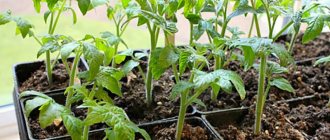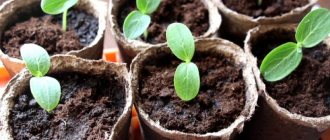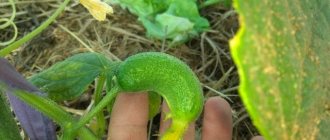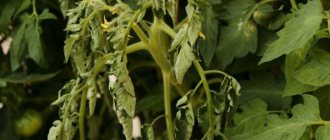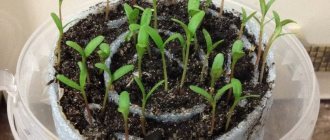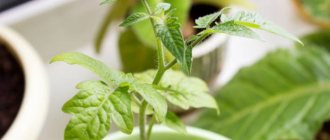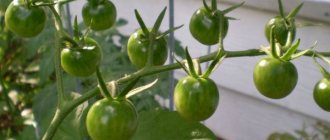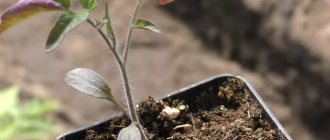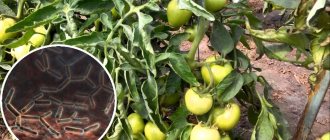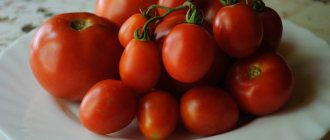Unsuitable soil
Tomatoes grown from seed at home or in a greenhouse wither due to an incorrectly selected soil mixture.
Acidic and dense soil entails:
- yellowing;
- falling off;
- drying of seedlings at the rhizome.
In addition to unsuitable soil, the reason may lie in the presence of pathogenic microorganisms or harmful beetles in it. This happens in the absence of preliminary disinfection. The procedure is carried out with a weak solution of potassium permanganate or hot water 90 degrees, calcination of the earth or freezing.
Advice from experienced gardeners
If the soil is moist, watering is correct, but the tops still wither, then succinic acid will help again. First dissolve the acid packet in hot water, then pour it into a bucket and pour over the tomatoes. After 3 days, you can repeat the same watering.
If this does not help, then the tomatoes should be fed with the following composition: 10 g of calcium nitrate and 10 g of ammonium nitrate should be diluted in a bucket of water. Pour from 0.5 to 1 liter at the root, depending on the growth of the seedlings.
This fertilizer will help make the stem thicker, increase the green mass so that the upper ovaries begin to form.
Unsuitable place for growing seedlings
Containers with seedlings should not be placed under a window; tomatoes do not like drafts. There should be no cracks in the windows, otherwise the cold wind will blow through them. Gaps should be sealed beforehand or after planting if the seedlings begin to wilt.
It is necessary to place the container at a distance of 10 cm from the window glass. You can place a folded newspaper between the window sill and the box.
Mistakes when feeding tomatoes
Sometimes seedlings wither and get sick due to a lack of nutrients in the soil. This often happens when the soil is prepared independently. Feeding is extremely important, especially in the early stages of tomato development. Purchased soil contains many useful substances, but tomatoes quickly use them up.
You can feed vegetables correctly, but keep them in a cold room, which will negate the results of fertilizers. Excess fertilizing (especially nitrogen) can also lead to tomatoes falling off. The root may turn yellow or die due to burns.
Excess organic fertilizer
Too little is bad, but too much is even worse. An excess of applied compost (in particular, fresh), watering with weakly diluted solutions or fertilizing with herbal infusions in excessive amounts leads to the fact that tomatoes (and other crops too) are unable to absorb such a volume of nutritional components and, to slow down the absorption process, the leaves begin to curl, which slows down photosynthesis.
Tomato leaves also wilt due to disease. The disease usually develops in protected soil. The leaves begin to dry first, and then the whole plant. The method of treatment always depends on the type of lesion. For example, bacterial plant cancer cannot be treated at all.
Lack of mineral components in the soil. Tomatoes, like any plant, welcome feeding, and if the soil is poor in mineral components, the leaves of the tomatoes will wither
Watering errors
Tomato bushes may fall or wilt due to excessive watering or lack of moisture. The least harm is caused by short drying of seedlings. If they “hang their ears”, you need to water them, but carefully. Don't pour too much water. First, the soil is slightly moistened, then, after 2 hours, it is irrigated again. Usually tomatoes recover without consequences.
Excess moisture is fraught not only with withering, but also with rotting of the root system and black leg. If the overflow was accidental, you should immediately dust the soil with wood ash.
When tomato seedlings die after regular heavy irrigation, how to save them:
- remove the plants from the wet soil, clean the roots from it;
- prick the tomato bushes into new, slightly moistened soil;
- Using a tablespoon, carefully pour each bush with a weak solution of potassium permanganate;
- treat the leaves with Epin's solution.
If you spray the leaves too hard, the soil will appear moist. This is a dangerous phenomenon, since only the top layer is saturated with moisture. Tomato seedlings should be watered 2-4 cm deep.
From an overabundance of fertilizing, a whitish crust may appear on the surface of the earth, preventing normal irrigation. The top layer of damaged soil should be carefully removed. Subsequent watering should be done with a weak solution of Humate. The product acts as a light fertilizer and stimulant that improves soil structure.
How to prevent leaf curl
Very often, tomato leaves curl. In hot weather they have little moisture, and curled leaves evaporate less. To fix this, you need to water it properly. There is no need to pour all the water under the bush at once. It is necessary to water in two steps. First pour about 2 liters, and then another 3 liters.
Advice: there is no need to water frequently; it is better to loosen and cover with mulch to prevent the soil from drying out.
Why else can leaves curl?
- If unrotted manure was introduced, then the root system is inhibited. The leaves begin to curl and the bush withers.
- Insufficient feeding can also cause wilting. Do not get carried away with nitrogen fertilizers, otherwise the tomatoes will begin to fatten.
- If all the plantings began to die, then they were affected by late blight. If a disease is noticed, it must be treated immediately.
- The greenhouse must be ventilated. And also make sure that the tomatoes are not eaten by aphids and whiteflies.
- You should not pick off many shoots and leaves at one time. The plant will be sick.
Low light
Why tomato seedlings on the windowsill get sick and die - another reason is the lack of lighting. At the initial stage, the problem is detected by external signs, the seedlings are stretched.
What to do if tomato seedlings wither on the window:
- Requires natural or artificial lighting for 12 hours a day;
- on cloudy days, tomatoes are illuminated with ultraviolet lamps.
Excessive light at home also has a detrimental effect on tomato seedlings. The leaves turn yellow, dry out, and wither. Then all the tomato seedlings on the window wither. At night, there is no need to illuminate the bushes with ultraviolet lamps, since in the dark they absorb the required substances and oxygen.
Why do the leaves curl?
Even a specialist in plant diseases will not immediately determine why the leaves of tomatoes curl in a greenhouse. There can be many reasons for this.
Root damage
Root damage in tomatoes
Usually the root is injured when planting seedlings in the ground. The roots of seedlings are brittle and easy to damage. The gardener may not notice the microtrauma, but the leaves of such bushes will be curled for several days.
Important! When there are a lot of seedlings, they outgrow and stretch out. And root damage and, as a result, leaf curling occurs precisely in overgrown seedlings
As a rule, during the growth process the injury heals, and the leaves return to their original state. Also, biotrauma of roots can occur when loosening the soil. The main roots are deep, but during the growth process small roots grow on the stem underground. Therefore, it is not advisable to loosen the soil deeper than 4 cm.
Improper watering
The second possible reason is a lack or excess of moisture. The branched root system of the bush needs abundant watering and, if there is not enough moisture, the root does not have enough nutrition. This is one of the most common reasons why a leaf can curl into a tube.
Wrong watering of tomatoes
Watering the bush should be moderate. If the greenhouse in which the tomatoes are grown is made of polycarbonate, the soil must be moistened once every 3 days. Approximately 1 bucket of water is consumed per bush.
Wetting of the root is done gradually: the water should nourish the soil without spreading to the sides. After watering, the beds must be loosened and mulched.
Note! With weak watering that does not reach the roots, the leaves on the plant curl up. Moreover, they remain green in color and have no visible signs of insect damage.
Excess moisture will also negatively affect the plant. With stable waterlogging, the roots do not receive the oxygen they need, informing about this by turning up the leaves. An imbalance of moisture will ultimately lead to smoldering of the roots, the development of fungus, and wilting of the bush.
Temperature violation
Despite the fact that tomato is a heat-loving crop, an increase in air temperature to 35 degrees or higher will have a negative impact on the plant: it can “burn out”. Curling of leaves can also be a reaction to heat.
At high temperatures, tomato leaves may “burn”
Whether elevated air temperature is the cause can be determined visually. In this case, by the evening, when the heat subsides, the leaf blade is completely straightened.
To lower the temperature and bring the plants back to normal, it is necessary to ventilate the greenhouse. Another method of relieving a stressful situation is to irrigate the bush with a urea solution. To do this, dissolve 1 tablespoon of the substance in a bucket of water. This will also provide nitrogen fertilization. The procedure is carried out in the evening.
Incorrect bush formation
When forming a bush, an agrotechnical technique is used - pinching. The essence of the method is to remove side shoots. They take away from the plant the nutrition necessary for the formation of fruits. The stepsons themselves do not form the ovary, and if they do, the tomatoes turn out to be small.
Growing tomatoes
Without stepsons, fruiting shoots use fertilizers and other nutrients from the soil more efficiently. Without unnecessary branches between the bushes, air circulation improves, thereby preventing diseases.
The mistake lies in early removal of stepchildren. Green mass is a kind of conductor of nutrients. If the plant has not yet taken root, and the lateral branches have already been removed, the path for delivering nutrition from the root to the branches and back is disrupted.
As a result of this failure, the leaves of the tomatoes curl up. Foliar feeding can help the bush.
Advice! To avoid this situation, the first removal of axillary branches is carried out 20 days after planting the tomatoes in the greenhouse.
If the answer to the question is found: “Why do the leaves of tomatoes curl in a greenhouse?”, you need to eliminate the cause as soon as possible. As a rule, after this the leaves straighten without consequences for the plant. But if the cause is not eliminated, the bush may die.
Temperature violation
Often there are limp tomatoes due to non-compliance with the temperature regime. If the air in the room warms up by more than 36 degrees Celsius, the plants overheat and dry out. Do not leave containers near heating appliances.
At low temperatures - up to +15 - tomatoes stop growing. Normal indicators for warming up the air in the room are +18-20 degrees. To harden tomato bushes, they are placed overnight in a cool place where the thermometer fluctuates between minus 3-4 degrees.
Tomato seedlings fell and withered in the greenhouse: reasons
Sometimes tomato bushes transplanted into a greenhouse do not take root well, wither and fall off.
The reasons for this phenomenon include the following circumstances:
- sprouts are transplanted too early, before the formation of 2-3 full-fledged leaves;
- in the greenhouse - increased temperature;
- the rhizomes were damaged during mechanical transplantation;
- There are larvae of harmful beetles in the soil.
To prevent the death of planting material, the soil in greenhouses must be pre-treated from harmful insects and infections. Preventive cleaning of greenhouse structures and soil treatment should begin immediately after collecting the remains of fruit-bearing plants. The contaminated soil is completely removed from the greenhouse, and steamed soil is added instead. Before planting the seedlings, pour boiling water into each hole - 2-5 liters. After the beds are treated with a weak solution of potassium permanganate.
If the planting dies after regular heat in the greenhouse, it is necessary to open the windows or door. There should be no drafts in the greenhouse. In greenhouses it is also important to carry out drip irrigation. Due to such a system, there will be enough liquid to ensure the successful development of the bushes.
Why do seedlings disappear? Sometimes the rhizome of tomatoes is damaged mechanically during transplantation, then the top with leaves has a stunted appearance and may fade. After a while, the sprouts dry out completely. When replanting, you should carefully remove the roots along with the earthen lump. 2-3 hours before transplanting, water the soil abundantly with water. It is more convenient to replant tomatoes sown in peat cubes or pots. The containers are lowered into the holes along with the tomato sprouts.
Prevention
You can avoid wilting of foliage using simple rules for growing tomatoes:
- Maintain crop rotation. Preventing the development of many diseases can be avoided by planting tomatoes in a new place every year. You can return to the old way after at least 3-4 years, which is exactly how long the fungus needs to become non-hazardous. Under no circumstances should you plant tomatoes after potatoes and other nightshade crops, as they have common diseases.
- If the greenhouse is small in size, then it will have to be moved to another place every year or the soil in it will have to be completely replaced.
- Before planting seedlings, disinfect the greenhouse soil with copper sulfate.
By the way! Annual sterilization of the frame and walls of the greenhouse will also not hurt.
- For better lighting and ventilation of the bushes, plant no more than 4 seedlings per square meter. Remove the lower leaves so that they do not create shade and do not create poor absorption of moisture by the soil.
- As a preventive measure, fertilize tomatoes with the organic preparation “Effekton-O”.
- Spray tomatoes regularly with antimicrobial agents. The best fungicides include the following: Quadris, Hom, Ridomil, Agat, Fundazol, Maxim, Ordan.
- Many diseases occur when there is excess nitrogen in the soil. Do not use fresh manure to fertilize tomatoes - it negatively affects their health.
- For the full development of tomato bushes, regularly apply root and foliar fertilizers containing a number of essential mineral elements.
- To grow new root shoots and strengthen plants, hill up tomatoes. The root collar should remain at least 15 centimeters underground.
- After harvesting, remove all plant debris from the ground. The soil should be dug up and disinfected.
Treatment of tomato diseases
Diseases of tomato seedlings develop after picking in a greenhouse or when they are already growing in the garden. You need to act urgently, otherwise the bushes may dry out completely.
Each disease requires an individual approach:
- Fusarium. Pathology develops due to insufficient disinfection, complete lack of tillage of the soil and containers where the seedlings grow. Fungi infect the plant, the stem becomes sick and is deprived of the required nutrition. Afterwards all the seedlings die. The bushes are carefully removed from the ground and inspected. On large seedlings, the vessels in the lower part of the shoots become dark brown. Severely affected seedlings with withered rhizomes and leaves are burned. To cure tomatoes, at the initial stage they are treated twice with Fundazol, 10 grams per 10 liters of water. The bushes are transplanted onto new soil disinfected with potassium permanganate. It is important to disinfect new containers as well.
- Blackleg. The disease develops when moisture stagnates. The rhizomes rot, which entails the death of the seedlings. The first symptom is blackening of the stems at the root collar. The disease is difficult to treat and almost impossible to treat. At the initial stage, tomato seedlings are transplanted into new soil treated with manganese solution. The root system is sprayed with crushed charcoal or ash before transplanting. As a form of prevention of blackleg, planting in a purchased soil mixture is used. After watering, it is sprinkled with sand.
- Rot. From an excess of moisture and heat, rot sometimes develops. The leaves turn yellow, fall off, and rot. It is impossible to save seedlings at home. It is pulled out with its rhizome and thrown away, and healthy tomatoes are transplanted into other containers, the watering regime and temperature indicators are strictly observed.
The above diseases rarely develop in tomatoes grown according to agrotechnical requirements.
Diseases leading to leaf wilting
One of the most dangerous fungal diseases of tomatoes that causes wilting of greens is fusarium, which is transmitted through potatoes. The first symptoms of spread appear in the damage to the lower leaves - they wither and turn yellow. Soon, entire shoots, flowers, and fruits begin to wither. An accumulation of conidia can be observed in the areola of the root collar: a pinkish-whitish coating appears in this place. Fungal spores wander through the vessels of the plant, gradually covering it entirely.
The thing is that the fungus can live in the ground for many years, waiting for the tomatoes to populate. As soon as young seedlings enter the soil and a favorable situation occurs (high humidity, excess nitrogen, temperature above 27 degrees), the fungus is immediately activated, penetrating first into the roots, and then spreading throughout the body of the tomato bush.
By the way ! Fusarium is found everywhere in greenhouses, since the greenhouse climate is ideal for the growth of the fungus.
Other fungal diseases that cause foliage wilting include late blight, verticillium, and sclerotinia. The pathogens act in the same way as with fusarium - penetrating inside the stem, the fungi spread throughout all organs, affecting them one after another. As a result, foliage, branches, flowers and fruits wither.
Viral infections that affect leaves include internal leaf necrosis, streaking, and mosaic. Bacterial - bacterial cancer, black spot.
Pests of tomato seedlings
Another reason why tomato seedlings wither is the attack of harmful beetles. This happens even in greenhouse conditions. They are affected by the larvae of cockchafers and mole crickets. Harmful insects eat the lower part of the stem and rhizomes, causing the seedlings to dry out. The beetles are destroyed with insecticides such as “Anti Khrushch” and “Stop Khrushch”.
When the sprouts have been chewed by a mole cricket or its larvae, they must be removed. It is difficult to combat because the pest is underground. Use granular products and dig them into the soil. The drugs “Grom”, “Force”, “Grizzly”, “Pochin” are widely used. You can also use agrotechnical methods - excavating nests, destroying masonry, loosening rows, eliminating fresh droppings in the form of fertilizer. In May, traps are made from manure, adding beer and vegetable oil to them. You can plant marigolds next to the tomatoes growing in the garden. The method of feeding tomatoes with ammonia, which repels harmful beetles from the garden, has also proven itself to be excellent.
Insect infestation
Often, exposure to pests causes the leaves on tomato bushes to wilt. A thorough examination of the underside of the leaves will help determine which insect attacked the tomatoes and effectively get rid of it.
- Aphids are localized in the folds of plants. It sucks the juice from the leaves, thereby causing them to wither and die. Repeated treatment of the beds with insecticides will help get rid of it.
- Whitefly larvae gather on leaves in order to eat them. Their waste products lead to the appearance of fungal diseases. The problem is that the whitefly is immune to serious poisons and has the ability to become accustomed to chemical insecticides.
- The appearance of spider mites on the bushes also leads to drying of the foliage. It focuses on the lower foliage, attacking the entire plant in a couple of weeks. Strong chemicals will be required to destroy it.

